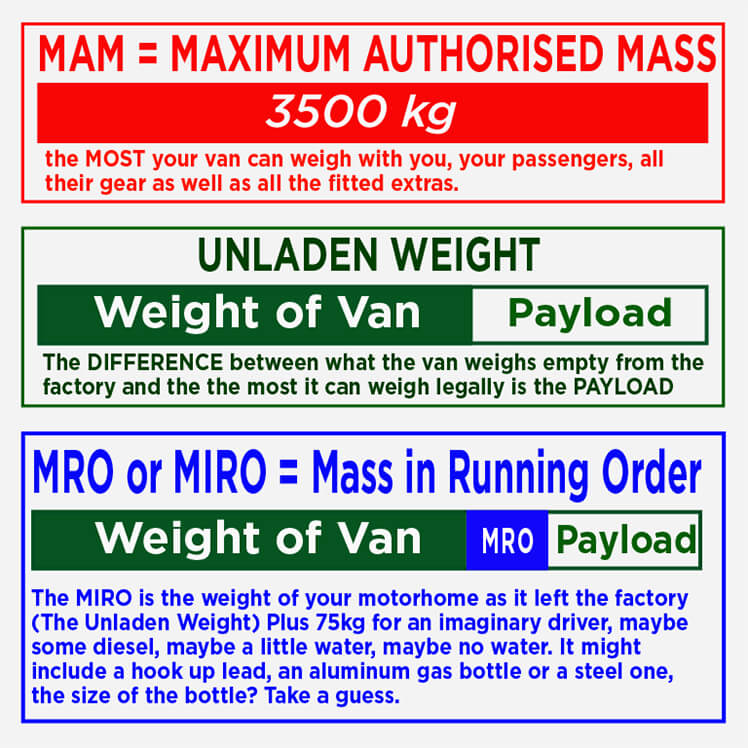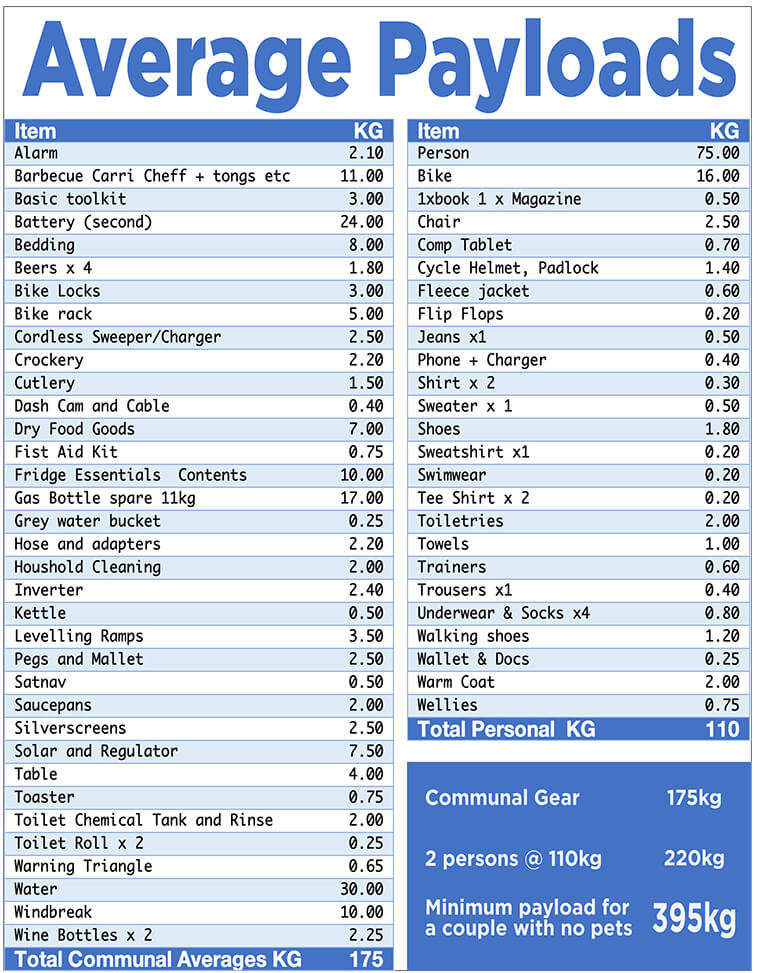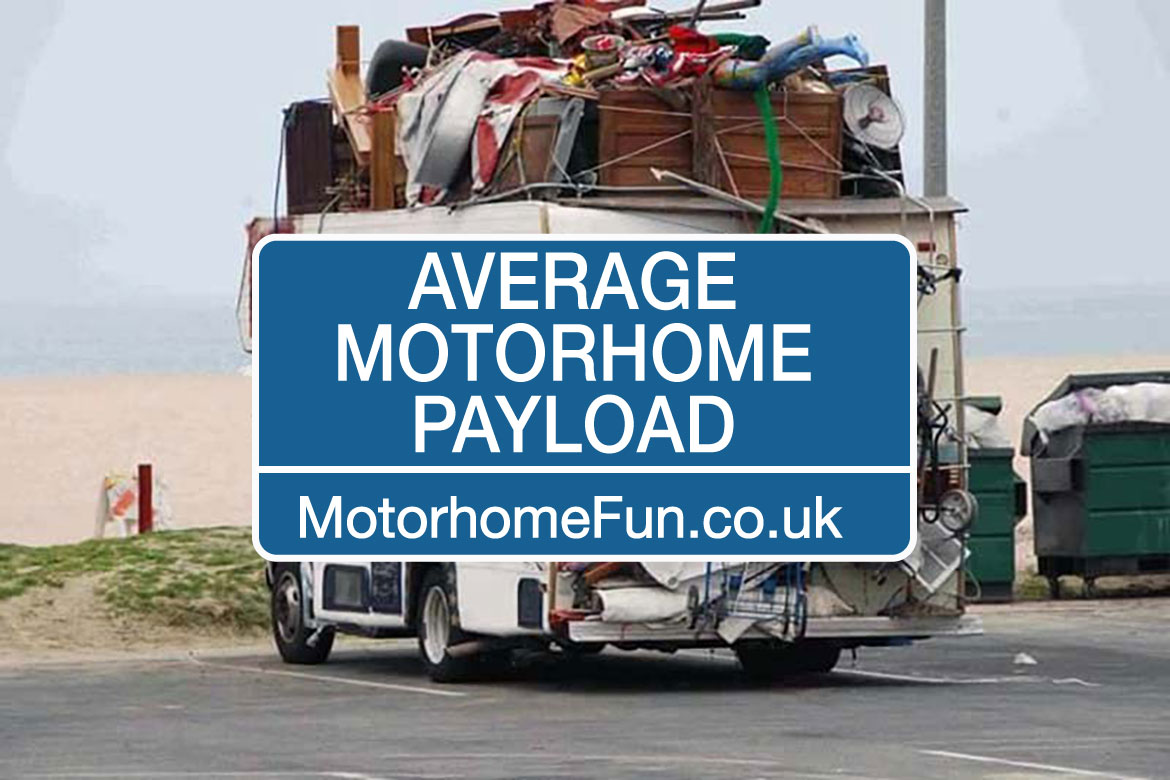If you’re not familiar with or don’t quite understand Motorhome Payload take a minute or so to study this graphic before reading further.

MIRO WE’RE NEVER QUITE SURE WHAT IS INCLUDED WITHIN THE FIGURES AND THE MAKERS ARE ALLOWED TO BE 5% OUT ANYWAY. MIRO IS A FUDGE. WORKING OUT YOUR PAYLOAD IS SIMPLE. FIRST YOU NEED TO WEIGH THE VAN. THEN SUBTRACT WHAT IT WEIGHS FROM THE MAXIMUM ALLOWED WEIGHT. THAT DIFFERENCE IS YOUR PAYLOAD
In this article, We take a further look at payload. Trying to find what some dealers and makers aren’t telling us and understand an Average Motorhome Payload
I guess very few people when buying a new motorhome, know precisely how much payload they will be getting. So why is this important figure such a mystery to so many?
Why do dealers and manufacturers leave it to the customer to find out what precise payload a van has?
While they might pay lip service to it in their literature, you can bet they will not give you a precise figure, and if they do they will qualify it by telling you how the law allows their figures to be 5% out in either direction. If you are starting with a tiny payload that 5% is significant.
To be legal, makers must ensure a minimum payload in accordance with The EU Directive for Masses and Dimensions. They derive this minimum using the following formula based on the length of the vehicle (L), the number of berths (N) and a figure for the “Conventional Load” (CL). The Conventional Load is the number of passenger seats (P) times 75kg.[/B]
The formula is 10xL + 10xN + 75xP = minimum payload in kg.
So, a 6-metre van with 4 berths and 3 passenger seats gives:
10×6 + 10×4 + 75×3 which breaks down to:
60+40+225 giving a total of 325kg
The problem the manufacturers have is trying to stay under a maximum all up weight of less than 3.5 ton. If the MAM goes over 3500kg then buyers will need Category C1 on their driving licence and this will restrict the numbers that can buy it.
Most people who passed their test before 1 January 1997 will have a C1 licence. This entitles them to drive a vehicle up to 7500kg; from this date the standard driving test only provides for driving a vehicle of up to 3500kg.
Staying under is easy with ‘no frills’ vans. If you read the review that we did last month of the Sun Living A70DK, here was an excellent family van under 3.5ton and it had a reasonable payload. There are many other examples.
However, as soon as you add double floors and insulated tanks along with quality furniture, then you squeeze that 3.5ton limit.
This means in practice that most 3.5 ton vehicles designed for a couple have just about enough pay-load. However, many family vans struggle to stay under enough to afford a realistic payload.
Sometimes, it would seem, the makers just don’t care. They put the onus on the end user with dire warnings in their handbooks about the dangers of overloading, but provide so little payload’ that overloading is almost inevitable for normal use.
Just because they don’t shout about the tiny payload doesn’t make us any less guilty or culpable for running overweight.
SO WHAT IS A REALISTIC AVERAGE MOTORHOME PAYLOAD?
We polled hundreds of motorhome owners and asked them for a detailed breakdown of what they carry. Now while some like to travel with a case of their favourite wine, others are happy with one bottle, some might have 4 extra batteries some stick with one.
What we try to do is find the reasonable average. For example, the majority of motorhomers have fitted extra batteries, the average is just one extra.
Hardly surprising when some makers, desperate to keep costs and weight down, fit a tiny 75AH battery which the majority of users find is inadequate. So we include 25kg for an extra battery in our realistic real-world payload. Most of you fit a solar panel too, so it should include this.
WATER WATER EVERYWHERE
Sometime back in 2016 the NCC allowed manufacturers to specify payload with empty water tanks. Our poll showed that the vast majority of people preferred to travel with full tanks. Water is heavy and travelling with full tanks will put a lot of people over, so we settled on an essential 30 litres. That’s 10L in your water heater and 20L for teas and trips to the loo.
WHEN YOU UNDERSTAND HOW MUCH AN AVERAGE MOTORHOME PAYLOAD IS YOU WILL NOTICE SOME DEALERS SELLING VANS WITH PAYLOADS SO LOW THAT YOU CANNOT SET OFF WITH FULL TANKS!
If you are Britstopping or wild camping being full when you set off is very reassuring. For me at least, having to faff about filling when I arrive anywhere is unacceptable, so I would never restrict myself that way. I want to travel with full tanks at all times.
I asked a young motorhome salesman at a show last year if the payload given had accounted for any water in the tanks. I was told that they did not include any water within the payload figures as by law the water tanks could have no more than 20l in them while travelling because of the severe stresses on the tank and how the handling of the motorhome might be dangerously affected!
CHILDREN
Even though kids weigh less than adults, their payload requirements are similar, which is their bodyweight plus 35kg, so add your children’s weight and add 35kg
YOU HAVE TO ASK
Last year at lots of different shows and at dealers premises, it was hard to find details about payload. When I asked they rarely gave me an accurate figure. I’ve had lots of “not quite sure, I’ll check”. Plenty of “Oh there’s loads on this model” and many times I’ve been lied to, mostly because they didn’t know. Things like; “Pretty sure it’s almost three-quarters of a ton on this one” (it was actually less than 400kg.)
LOOK AT THE AVERAGE MOTORHOME PAYLOAD TABLE AND YOU’LL SEE THAT A COUPLE WILL NEED A PAYLOAD OF AROUND 400KG.

Add any children; 35kg plus their weight, and you should have a good handle on what you’ll realistically require.
Remember our figures are averages, you may be higher (most likely) or lower. Once you know the payload you’ll likely need, then when. you are at the dealers ASK AWAY.
“What’s the payload on this model?”
FACT IS, IF YOU DON’T ASK THEY AREN’T GOING TO TELL YOU!


